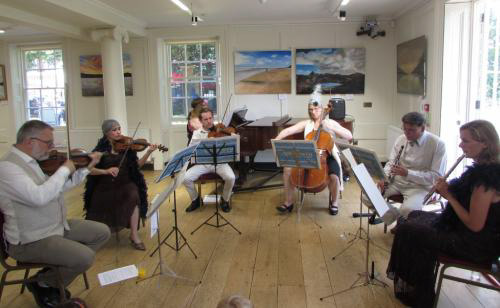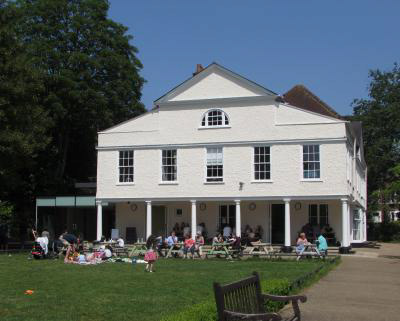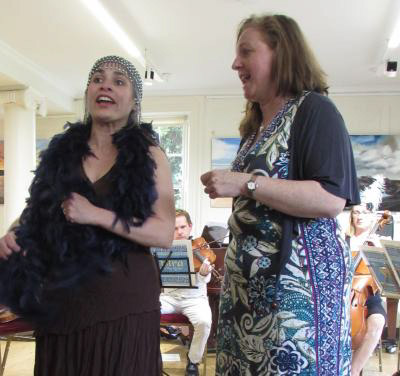
Another twelve months have sped by, and it was time for the 2018 May Bank Holiday concert performed by the Aspidistra Drawing Room Orchestra, which took place once again in the Gallery of Lauderdale House, Highgate Hill, in North London. This house has a long history; it dates from 1582 and was briefly the home of King Charles II's mistress, the famous (infamous?) Nell Gwyn, whose ghost is reputed to haunt the building even unto this day!

Uncharacteristically glorious weather encouraged an excellent turnout, including several from the LLMMG (and their guests) and an unexpectedly large number of most welcome 'first-timers', in addition to many loyal 'regulars' – some of whom have supported every single one of these concerts during the last sixteen years.
As one of woefully few contemporary exponents of the Palm Court genre, the orchestra always manages to surprise and delight its audiences with new material, which is continually being added to an already extensive repertoire. This year's programme was no exception, and much of the music was totally new to the players!
Their mission is to feature compositions which have been totally forgotten or ignored, alongside more familiar favourites, and these can range from 'the highlights of the Palm Court era to the delightful but obscure', to quote from their concert programme.
Amongst the roll-call of 'more familiar' composers were to be found the names of Jack Strachey, Vittorio Monti (of Czardas fame), George Gershwin (his opus 1, Rialto Ripples) , Albert Ketelbey, Matyas Seiber, Oscar Straus, Haydn Wood, (who lived for some years in Highgate, quite close to the venue), Gerhard Winkler and Cole Porter.
In addition to the purely instrumental pieces, the proceedings were - as always - enlivened and garnished with some songs from Liz Menezes (who also plays second violin) and Camilla Cutts.

As has been remarked upon in the past, the members of the ensemble perform with great competence and enthusiasm, and the Aspidistra Drawing Room Orchestra can arguably be regarded as one of the very best of its type.
Congratulations and very many thanks are therefore due to Adam Bakker and his players for another splendid and extremely enjoyable afternoon of wonderful music.
© Tony Clayden 2018
Pictures courtesy of Brian Luck
Footnote – The ADRO will be our guests at the next LLMMG event in October, at our usual venue in Central London - click here for full details.
As part of the Camden Fringe Festival, they are also giving two concerts at Burgh House, Hampstead, North West London, on Sunday 19th August, at 2.30 pm and 7.00 pm - click here for full details.
(Cyril Mockridge)
Al Caiola’s Orchestra
Analysed by Robert Walton
Of all movie music there’s nothing so instantly recognizable as a western theme. This is because many of the best stories of the Wild West captured the ultimate desire and desperation of the human spirit to journey into the unknown in search of a better life. This was the dream of millions of Americans.
(Cyril Mockridge)
Al Caiola’s Orchestra
Analysed by Robert Walton
Of all movie music there’s nothing so instantly recognizable as a western theme. This is because many of the best stories of the Wild West captured the ultimate desire and desperation of the human spirit to journey into the unknown in search of a better life. This was the dream of millions of Americans. Still is perhaps. According to the Marx Brothers, “Go West” is where the sun always shines and the fun never sets! But in reality it was nothing like that. Anyone determined enough would take the “plunge”. And there were not only mighty rivers to cross, but also plains and deserts to traverse and mountains to climb. And with that hope came an almost religious fervour calling upon God to give them guidance in their quest and bring them safely to their destination. So hence good western themes have an almost hymn-like or folkish quality with the immigrant’s blind faith in their future prospects. All this positivity produced good vibes and hopefully a happy ending. So let’s focus on one such theme.
Television arrived in New Zealand as late as 1960. One of the first series I remember was “Laramie” in back and white. But even more than the storylines, what truly struck a chord was the gorgeous theme by Cyril Mockridge. British-born Mockridge, arranger, pianist and composer emigrated to America in 1922 and was staff composer for 20th Century Fox from 1935 until 1961. Although he wrote the soundtracks for many well known films including “River of No Return”, “The Man who Shot Liberty Valance” and “Cheaper by the Dozen” his name never meant much to the general public. Perhaps it was because he often orchestrated scores for some of the big names and didn’t always get the credit. Incidentally his surname has Devonian origins.
Al Caiola, a highly respected studio guitarist, who played for Percy Faith and André Kostelanetz, takes care of the opening chorus. Then what we’ve all been waiting for, the strings enter in clippity clop-trot tempo with that unforgettably strong tune supported by the horns. From here to the end, the guitar and strings take it in turns to play. It’s the strings that eventually win out declaring their total dominance of the situation. Listen to the way the melody climaxes before coming down to earth.
Hear it on 100 Greatest American Light Orchestras - 2
Golden Age of Light Music, Guild Records (GLCD 5231)
Report on the spring gathering of the London Light Music Meetings Group on Sunday 6th May 2018
Written by London Light Music Meetings GroupIt was a sunny and unseasonably warm day at the Lancaster Hall Hotel, as Light Music enthusiasts arrived for another feast of melodic music - now almost unobtainable on the BBC!
After opening - appropriately - with George Melachrino's Spring Morning, Tony Clayden welcomed the multitude, and read out a number of apologies for absence for those who were either unwell, or whose commitments during this Bank Holiday weekend rendered attendance impossible.
(George Elliott)
Analysed by Robert Walton
In the 1970s when British commercial radio became legal, George Elliott was Head of Productions at LBC (the London Broadcasting Company off Fleet Street). We first met in that capacity when I was a voice over artist. He was also a commentator but I had no idea he was a composer as well. Clearly a man of many talents.
(George Elliott)
Analysed by Robert Walton
In the 1970s when British commercial radio became legal, George Elliott was Head of Productions at LBC (the London Broadcasting Company off Fleet Street). We first met in that capacity when I was a voice over artist. He was also a commentator but I had no idea he was a composer as well. Clearly a man of many talents.
His Piccadilly Playboy was along the lines of Robert Farnon’s ManhattanPlayboy but eminently less frantic with a more basic orchestration. Strangely enough before Bob moved to Guernsey, the Farnons and Elliotts were neighbours in Gerrard’s Cross. Perhaps George caught the musical bug in Buckinghamshire. He remembered the occasion Bob wrote Bird Charmer for his son David. The inspiration for the title actually came from David’s mother Pat who said that “he could charm the birds out of the trees!”
But this is George Elliott’s Piccadilly Playboy written in 1958 and played by the Symphonia Orchestra conducted by Curt Andersen. It starts with 4 bars of busy woodwind and muted brass straight into the arms of waiting unison strings for a lesson in the art of smooth legato phrasing. At the appropriate moments decorative woodwind slot in to this pleasant 1940’s-type mood music melody.
There’s a noticeable moment’s silence before the bridge begins. Normally this would be filled with orchestral activity but the arranger decided on this occasion to have a deliberate pause. The rhythm section you’ll observe is barely audible. The brass takes the lead while arco strings steadily climb up for decorative duties changing to pizzicato. Another silence.
Back to the main strain as the strings now in harmony keep things moving. Yet another silence. Unison strings play another section, effectively a bonus bridge. After much coming and going we eventually find ourselves back at the official bridge.
Before you can say “George Elliott” the opening is repeated and we go headlong towards the close. Piccadilly Playboy builds up to a satisfactory conclusion with a positive brass assisted finish. It all sounds so effortless.
The English playboy mightn’t be quite as hurried as the American but predictably is more formal and laid back.
Can be heard on
“Light and Lively”
Golden Age of Light Music
Guild Records (GLCD 5160)
(Leon Pober)
Lou Busch’s version analysed by Robert Walton
The hit parade has never exactly been littered with light orchestral pieces, but from time to time one appeared amongst a sea of vocal numbers. The most original and imitated in the 20th century was David Rose’s Holiday for Strings, his first disc to sell a million. Mantovani’s Charmaine, Leroy Anderson’s Syncopated Clock and Frank Chacksfield’s Limelight were three others to make the charts. Sometimes though, the B sides of million sellers deserved to be heard too...
(Leon Pober)
Lou Busch’s version analysed by Robert Walton
The hit parade has never exactly been littered with light orchestral pieces, but from time to time one appeared amongst a sea of vocal numbers. The most original and imitated in the 20th century was David Rose’s Holiday for Strings, his first disc to sell a million. Mantovani’s Charmaine, Leroy Anderson’s Syncopated Clock and Frank Chacksfield’s Limelight were three others to make the charts. Sometimes though, the B sides of million sellers deserved to be heard too.
One such title turned up on the radio in the mid-50s when I was doing three months Compulsory Military Training in New Zealand. It was Rainbow’s End on the back of Lou Busch’s Zambesi and stood out as a relaxed waltz of quality in an era when rock ‘n roll was threatening to take over. I must admit I had completely forgotten its name, let alone the melody. Consequently it took a bit of time to track down.
It has an unusually long introduction and for a generally quiet arrangement the record begins with a startling blast like a wind storm, gradually becoming softer. The listener is hypnotized into a kind of dream world. A trilling flute gently welcomes us to this tender string tune. After a while woodwind and an ascending Les Baxter-type humming chorus join the orchestra. When the strings, piano and singers really get going one wonders why Rainbow’s End didn’t become better known. In fact it’s not unlike a Henry Mancini melody. Later the arrangement creates a joyous atmosphere with a distinct bell-like effect. Then the brass contributes to a key change.
An accordion leads the way with brass, orchestra and more bells. Suddenly we find ourselves in a hauntingly peaceful coda with the strings high on harmonics. A flutter of flutes, muted brass, sustained strings and a glorious harp glissando gives a solo flute the final fling.
In conclusion, a few words about composer Pober (born 1920 Massachusets died 1971 Los Angeles). Four of his best known songs are Sweet Treat, Tangi Tahiti (The Call of Tahiti ), Tiny Bubbles and Pearly Shells. Artists who have recorded Leon Pober’s songs include, Burl Ives, Don Ho, Billy Vaughn and Dean Martin. In 1960 Pober wrote the musical Beg, Borrow or Steal with jazz tenor sax player Bud Freeman. Also they composed Zen is When for the Dave Brubeck Quartet. Did you realize “rebop” is Pober spelt backwards?
Can be heard on
The Golden Age of Light Music “Light and Lively” Guild Records (GLCD 5160)
Naxos 8.573680 Royal Norwegian Navy Band conducted by Bjarte Engeset.
This latest ‘thriller’ from The Halle – "Classic Movie Thrillers" -part of the Nottingham Classics concert series - was faultless as was the informative compeering from a very knowledgeable Petroc Trelawny who presents BBC Radio 3’s ‘Breakfast’.

